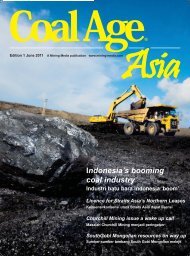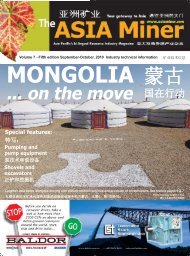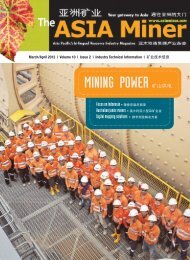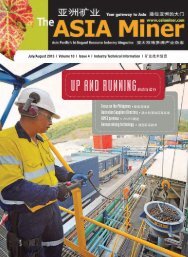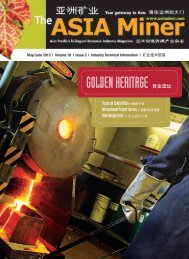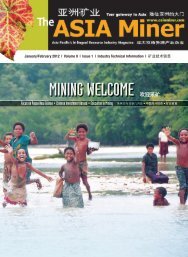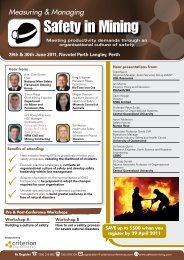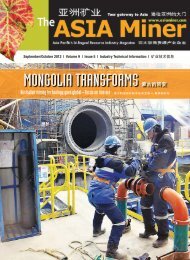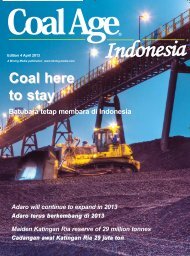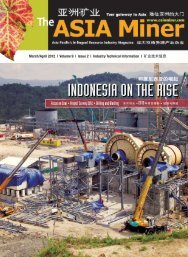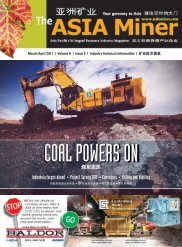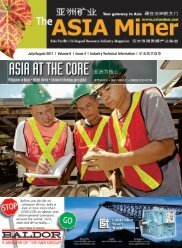Volume 9 Edition 3 2012 - The ASIA Miner
Volume 9 Edition 3 2012 - The ASIA Miner
Volume 9 Edition 3 2012 - The ASIA Miner
- No tags were found...
You also want an ePaper? Increase the reach of your titles
YUMPU automatically turns print PDFs into web optimized ePapers that Google loves.
Papau New GuineaPapua New Guinea - the momentum is maintainedBy Magnus Ericsson, of Raw Materials GroupTHERE could be few more telling images of the momentum now behindmineral exploration and development in Papua New Guinea than thesight of the 650 delegates who attended the ‘Mining Sector – Buildinga Nation’ seminar last November in Port Mor esby. Organized by thePNG Chamber of Mines and Petroleum, the seminar included presentationsfrom 30 of the companies currently active in the country.Keynote speeches from the country’s Prime Minister, Minister for Miningand Chamber president set the tone for the meeting. “Papua NewGuinea’s mining and petroleum sector has been the most aggr essivedriver of our nation’s good economic fortunes for almost a decade,” saidPrime Minister Peter O’Neill. “Our government acknowledges the sector’scontribution to stabilizing and growing our economy since the economicmeltdown of the 1990s.“<strong>The</strong>re is no immediate desire on the part of government to reviewexisting mining and petroleum legislative and fiscal frameworks,”he stated, while giving the commitment: “Let me reassure you thatour government is committed to fast-tracking and facilitating pr o-cesses that will enable start-up of new ventures awaiting regulatoryclearance and licence approvals.”Porgera is one of PNG’s world-class projects. Photo Rocky RoeBefore updating delegates on the revision process for the country’smining legislation, Minister for Mining Byr on Chan providedsome information on the current position regarding mining and explorationlicences. “According to the recent updated mapping dataproduced by the <strong>Miner</strong>al Resources Authority (MRA),” he said, “todate over 80% of the PNG landmass is taken up by mining and explorationlicence as a result of launching the geophysical and geochemicalsurvey datasets during 2010.”<strong>The</strong> revision process includes speeding up the tenements administrationwith an online application process being introduced andother simplifications in the types of licences and their terms of validity.<strong>The</strong> government is also considering a possibility for it to takea stake of up to 30% in any mining development in PNG. Socialmapping and landowner identification will be required by law for allprojects as will community awareness programs and consultations.<strong>The</strong> Minister went on to discuss many more details in the proposedrevision of the mining legislation.<strong>The</strong> benefits of increased exploration are quickly feeding throughinto the wider community , according to chamber pr esident IlaTemu. Between 2005 and 2010, royalty payments from the miningindustry totalled nearly PGK820 million (US$385 million), with theamount growing each year, he said, while adding that dir ect employmentin the mining and petroleum industries had grown to over30,000. Exploration gives other job opportunities to communities,with growing demand for the whole range of logistic and technicalinput supporting a thriving service sector.ContextPNG became an independent nation in 1975 after Australia hastily leftthe country to gover n itself. It has a population of 7 million occupyingan area of 463,000sqkm. <strong>The</strong>re are more than 700 languages spokenon the mainland and the many inhabited islands in the Pacific. <strong>The</strong> geographyis extremely challenging with steep mountains and wild rivers.Infrastructure is sparse and it is not possible to drive by car acr oss thecountry. Travelling within PNG most often means taking a domestic flight.In spite of the poor starting point PNG has succeeded in building ademocratic society with elections held r egularly and r esulting inpeaceful changes of government. Sir Michael Somare, who was thefirst Prime Minister after independence and was r e-elected in 2002,was replaced in 2011 by Peter O’Neill.PNG is the largest economy in the Pacific. It is built on mining and minerals,and the country has benefitted greatly from the commodity boomin recent years. <strong>The</strong> sector is driven not only by metal mining but pr e-sently the most important project is the US$15 billion Exxon-Mobil ledPNG LNG project. On the back of this giant investment and other smallermining projects, the construction sector is booming. Other importantsectors of the economy ar e timber, palm oil and agricultural pr oductssuch as coffee and cocoa. Australia is the most important trading partnerbut China is increasing its share of both imports and exports fast.GDP grew 5.5% in real terms in 2009, followed by 7.1% in 2010and for 2011 it is projected that growth could reach low double digitlevels. <strong>The</strong> economy of PNG is not at all linked to the global debtcrisis, at least not so far. Exports and government earnings are heavilydependent on the mineral industries: In 2011 up to the 3r dquarter, export income from the mineral sector reached PGK7444or 59% of total exports. <strong>The</strong> growth in export income in 2011 overthe same period in 2010 was ar ound 8%. In the same period of2010 export income accounted for 63% of total exports.MiningModern mining started in the 1930s with the Bulolo gold dr edgingoperations. <strong>The</strong> rugged terrain and lack of infrastructure made theseearly endeavours the first fly-in fly-out operations in the world. Cur -rently there are three world-class mines in PNG - Ok Tedi copper, Lihirand Porgera gold mines. Several projects are under development, inparticular the Ramu nickel operations. Many of the world’s leading miningcompanies such as Barrick, Newcrest, Xstrata, Harmony and othersare operating in PNG. Government is a major participant in themining industry, holding minority stakes, through several vehicles, aswell as majority positions in other companies.Small-scale and artisanal mining plays an important r ole in PNG.46 | <strong>ASIA</strong> <strong>Miner</strong> | May/June <strong>2012</strong>



